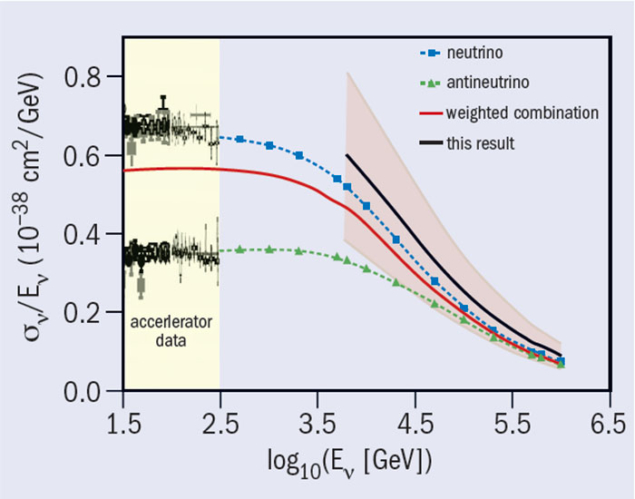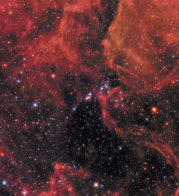

Neutrinos are popularly thought to penetrate everything owing to their extremely weak interactions with matter. A recent analysis by the IceCube neutrino observatory at the South Pole proves this is not the case, confirming predictions that the neutrino–nucleon interaction cross section rises with energy to the point where even an object as tiny as the Earth can stop high-energy neutrinos in their tracks.
By studying a sample of 10,784 neutrino events, the IceCube team found that neutrinos with energies between 6.3 and 980 TeV were absorbed in the Earth. From this, they concluded that the neutrino–nucleon cross-section was 1.30+0.21–0.19 (stat) +0.39–0.43 (syst) times the Standard Model (SM) cross-section in that energy range. IceCube did not observe a large increase in the cross-section as is predicted in some models of physics beyond the SM, including those with leptoquarks or extra dimensions.
The analysis used the 1km 3 volume of IceCube to collect a sample of upward-going muons produced by neutrino interactions in the rock and ice below and around the detector, selecting 10,784 muons with an energy above 1 TeV. Since the zenith angles of these neutrinos are known to about one degree, the absorber thickness can be precisely determined. The data were compared to a simulation containing atmospheric and astrophysical neutrinos, including simulated neutrino interactions in the Earth such as neutral-current interactions. Consequently, IceCube extended previous accelerator measurements upward in energy by several orders of magnitude, with the result in good agreement with the SM prediction (see figure, above).
Neutrinos are key to probing the deep structure of matter and the high-energy universe, yet until recently their interactions had only been measured at laboratory energies up to about 350 GeV. The high-energy neutrinos detected by IceCube, partially of astrophysical origin, provide an opportunity to measure their interactions at higher energies.
In an additional analysis of six years of IceCube data, Amy Connolly and Mauricio Bustamante of Ohio State University employ an alternative approach which uses 58 IceCube-contained events (in which the neutrino interaction took place within the detector) to measure the neutrino cross-section. Although these events mostly have well-measured energies, their neutrino zenith angles are less well known and they are also much less numerous, limiting the statistical precision.
Nevertheless, the team was able to measure the neutrino cross-section in four energy bins from 18 TeV to 2 PeV with factor-of-ten uncertainties, showing for the first time that the energy dependence of the cross section above 18 TeV agrees with the predicted softer-than-linear dependence and reaffirming the absence of new physics at TeV energy scales.
Future analyses from the IceCube Collaboration will use more data to measure the cross-sections in narrower bins of neutrino energy and to reach higher energies, making the measurements considerably more sensitive to beyond-SM physics. Planned larger detectors such as IceCube-Gen2 and the full KM3NeT can push these measurements further upwards in energy, while even larger detectors would be able to search for the coherent radio Cherenkov pulses produced when neutrinos with energies above 1017 eV interact in ice.
Proposals for future experiments such as ARA and ARIANNA envision the use of relatively-inexpensive detector arrays to instrument volumes above 100 km3, enough to measure “GZK” neutrinos produced when cosmic-rays interact with the cosmic-microwave background radiation. At these energies, the Earth is almost opaque and detectors should be able to extend cross-section measurements above 1019 eV, thereby probing beyond LHC energies.
These analyses join previous results on neutrino oscillations and exotic particle searches in showing that IceCube can also contribute to nuclear and particle physics, going beyond its original mission of studying astrophysical neutrinos.





